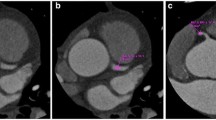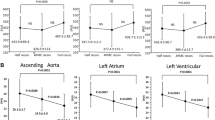Abstract
To assess the image quality and radiation exposure of 320-row area detector computed tomography (320-ADCT) coronary angiography with optimal tube voltage selection with the guidance of an automatic exposure control system in comparison with a body mass index (BMI)-adapted protocol. Twenty-two patients (study group) underwent 320-ADCT coronary angiography using an automatic exposure control system with the target standard deviation value of 33 as the image quality index and the lowest possible tube voltage. For comparison, a sex- and BMI-matched group (control group, n = 22) using a BMI-adapted protocol was established. Images of both groups were reconstructed by an iterative reconstruction algorithm. For objective evaluation of the image quality, image noise, vessel density, signal to noise ratio (SNR), and contrast to noise ratio (CNR) were measured. Two blinded readers then subjectively graded the image quality using a four-point scale (1: nondiagnostic to 4: excellent). Radiation exposure was also measured. Although the study group tended to show higher image noise (14.1 ± 3.6 vs. 9.3 ± 2.2 HU, P = 0.111) and higher vessel density (665.5 ± 161 vs. 498 ± 143 HU, P = 0.430) than the control group, the differences were not significant. There was no significant difference between the two groups for SNR (52.5 ± 19.2 vs. 60.6 ± 21.8, P = 0.729), CNR (57.0 ± 19.8 vs. 67.8 ± 23.3, P = 0.531), or subjective image quality scores (3.47 ± 0.55 vs. 3.59 ± 0.56, P = 0.960). However, radiation exposure was significantly reduced by 42 % in the study group (1.9 ± 0.8 vs. 3.6 ± 0.4 mSv, P = 0.003). Optimal tube voltage selection with the guidance of an automatic exposure control system in 320-ADCT coronary angiography allows substantial radiation reduction without significant impairment of image quality, compared to the results obtained using a BMI-based protocol.



Similar content being viewed by others
Abbreviations
- 320-ADCT:
-
320-Row area detector CT
- 3D:
-
Three-dimensional
- AEC:
-
Automatic exposure control
- AIDR:
-
Adaptive iterative dose reduction
- BMI:
-
Body mass index
- Bpm:
-
Beats per minute
- CNR:
-
Contrast-to-noise ratio
- CT:
-
Computed tomography
- CTDIvol :
-
Volume CT dose index
- D1:
-
First diagonal branch
- D2:
-
Second diagonal branch
- DLP:
-
Dose-length product
- ECG:
-
Electrocardiography
- ED:
-
Effective dose
- FOV:
-
Field of view
- HR:
-
Heart rate
- HU:
-
Hounsfield unit
- LAD:
-
Left anterior descending artery
- LCx:
-
Left circumflex artery
- LM:
-
Left main coronary artery
- OM:
-
Obtuse marginalis
- PDA:
-
Posterior descending artery
- RCA:
-
Right coronary artery
- SNR:
-
Signal-to-noise ratio
References
Park EA, Lee W, Kang JH et al (2009) The image quality and radiation dose of 100-kVp versus 120-kVp ECG-gated 16-slice CT coronary angiography. Korean J Radiol 10(3):235–243
Kurita T, Sakuma H, Onishi K et al (2009) Regional myocardial perfusion reserve determined using myocardial perfusion magnetic resonance imaging showed a direct correlation with coronary flow velocity reserve by Doppler flow wire. Eur Heart J 30(4):444–452
Lee CH, Goo JM, Ye HJ et al (2008) Radiation dose modulation techniques in the multidetector CT era: from basics to practice. Radiographics 28(5):1451–1459
Deetjen A, Mollmann S, Conradi G et al (2007) Use of automatic exposure control in multislice computed tomography of the coronaries: comparison of 16-slice and 64-slice scanner data with conventional coronary angiography. Heart 93(9):1040–1043
Francone M, Di Castro E, Napoli A et al (2008) Dose reduction and image quality assessment in 64-detector row computed tomography of the coronary arteries using an automatic exposure control system. J Comput Assist Tomogr 32(5):668–678
Jung B, Mahnken AH, Stargardt A et al (2003) Individually weight-adapted examination protocol in retrospectively ECG-gated MSCT of the heart. Eur Radiol 13(12):2560–2566
Tatsugami F, Husmann L, Herzog BA et al (2009) Evaluation of a body mass index-adapted protocol for low-dose 64-MDCT coronary angiography with prospective ECG triggering. AJR Am J Roentgenol 192(3):635–638
Yu L, Fletcher JG, Grant KL et al (2013) Automatic selection of tube potential for radiation dose reduction in vascular and contrast-enhanced abdominopelvic CT. AJR Am J Roentgenol 201(2):W297–W306
George RT, Arbab-Zadeh A, Miller JM et al (2009) Adenosine stress 64- and 256-row detector computed tomography angiography and perfusion imaging: a pilot study evaluating the transmural extent of perfusion abnormalities to predict atherosclerosis causing myocardial ischemia. Circ Cardiovasc Imaging 2(3):174–182
Kitagawa K, Sakuma H, Nagata M et al (2008) Diagnostic accuracy of stress myocardial perfusion MRI and late gadolinium-enhanced MRI for detecting flow-limiting coronary artery disease: a multicenter study. Eur Radiol 18(12):2808–2816
Leipsic J, Labounty TM, Heilbron B et al (2010) Adaptive statistical iterative reconstruction: assessment of image noise and image quality in coronary CT angiography. AJR Am J Roentgenol 195(3):649–654
Bittencourt MS, Schmidt B, Seltmann M et al (2011) Iterative reconstruction in image space (IRIS) in cardiac computed tomography: initial experience. Int J Cardiovasc Imaging 27(7):1081–1087
Chun EJ, Lee W, Choi YH et al (2008) Effects of nitroglycerin on the diagnostic accuracy of electrocardiogram-gated coronary computed tomography angiography. J Comput Assist Tomogr 32(1):86–92
Yoo RE, Park EA, Lee W et al (2013) Image quality of adaptive iterative dose reduction 3D of coronary CT angiography of 640-slice CT: comparison with filtered back-projection. Int J Cardiovasc Imaging 29(3):669–676
The 2007 recommendations of the international commission on radiological protection. ICRP publication 103. Ann ICRP 37(2–4):1–332
Raman SP, Johnson PT, Deshmukh S et al (2013) CT dose reduction applications: available tools on the latest generation of CT scanners. J Am Coll Radiol 10(1):37–41
Mulkens TH, Bellinck P, Baeyaert M et al (2005) Use of an automatic exposure control mechanism for dose optimization in multi-detector row CT examinations: clinical evaluation. Radiology 237(1):213–223
Hausleiter J, Martinoff S, Hadamitzky M et al (2010) Image quality and radiation exposure with a low tube voltage protocol for coronary CT angiography results of the PROTECTION II Trial. JACC Cardiovasc Imaging 3(11):1113–1123
Hausleiter J, Meyer T, Hadamitzky M et al (2006) Radiation dose estimates from cardiac multislice computed tomography in daily practice: impact of different scanning protocols on effective dose estimates. Circulation 113(10):1305–1310
Hausleiter J, Meyer T, Hermann F et al (2009) Estimated radiation dose associated with cardiac CT angiography. JAMA 301(5):500–507
Hsieh J (2003) Computed tomography: principles, design, artifacts, and recent advances, 2nd edn. SPIE Press, Bellingham
Ghoshhajra BB, Engel LC, Karolyi M et al (2013) Cardiac computed tomography angiography with automatic tube potential selection: effects on radiation dose and image quality. J Thorac Imaging 28(1):40–48
Siegel MJ, Ramirez-Giraldo JC, Hildebolt C et al (2013) Automated low-kilovoltage selection in pediatric computed tomography angiography: phantom study evaluating effects on radiation dose and image quality. Invest Radiol 48(8):584–589
Suh YJ, Kim YJ, Hong SR et al (2013) Combined use of automatic tube potential selection with tube current modulation and iterative reconstruction technique in coronary CT angiography. Radiology 269(3):722–729
Acknowledgments
This study was supported by Grant no. 06-2012-3020 from the Toshiba Medical Systems Research Fund.
Conflict of interest
Dr Shim is an employee of Toshiba Medical Systems Korea. None of the other authors have disclosed any conflict of interest.
Author information
Authors and Affiliations
Corresponding author
Rights and permissions
About this article
Cite this article
Lim, J., Park, EA., Lee, W. et al. Image quality and radiation reduction of 320-row area detector CT coronary angiography with optimal tube voltage selection and an automatic exposure control system: comparison with body mass index-adapted protocol. Int J Cardiovasc Imaging 31 (Suppl 1), 23–30 (2015). https://doi.org/10.1007/s10554-015-0594-1
Received:
Accepted:
Published:
Issue Date:
DOI: https://doi.org/10.1007/s10554-015-0594-1




